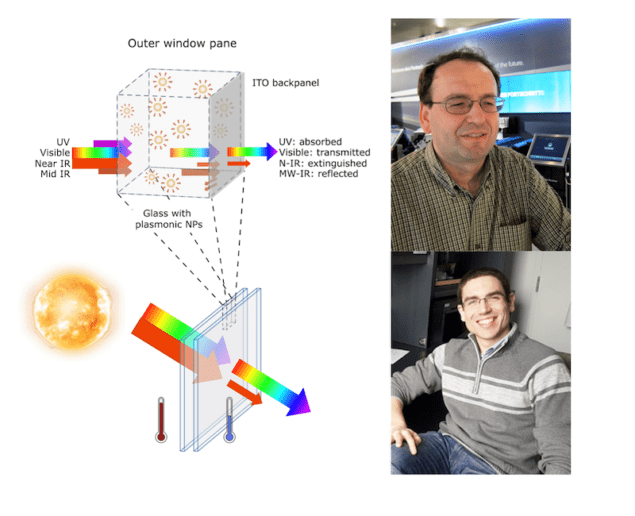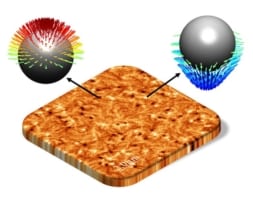
A new composite material developed by physicists at Ohio University in the US, together with colleagues in China and Canada, can be used to create cost-efficient glasses and films based on plasmonic crystals that block all ultraviolet and infrared radiation while remaining transparent to visible light. The researchers investigated how nanoparticles of different shapes and materials interact with light, and their findings could help in the development of windows that would reduce the amount of heat entering a room or vehicle, thus ultimately reducing the need for energy-hungry air-conditioning or other cooling systems.
There are several ways to make spectrally selective materials, explain Alexander Govorov and Lucas Besteiro in Ohio, who led this research effort. One involves covering glass with a multi-layered film that reflects infrared light, while transmitting light in the visible part of the solar spectrum. Another is to use near-infrared interacting materials that can block certain solar light wavelengths.
‘Metaglasses’ containing plasmonic nanocrystals
“In our work, we describe an approach to create passive infrared-blocking ‘metaglasses’ containing plasmonic nanocrystals. We show that mixtures of specially shaped plasmonic nanocrystals made of noble metals (silver and gold) and alternative plasmonic materials (titanium nitride, aluminium and copper) can efficiently block infrared solar radiation.”
Plasmonics is a branch of photonics that exploits surface plasmons (SPs) for enhancing light–matter interactions. These SPs arise from the interaction of light with the electrons, which makes them oscillate within the metal. Plasmonic metamaterials are artificially engineered collections of metal nanostructures that can be fine-tuned to interact with light in very specific ways. With these materials, it is possible to adjust the shape, size and arrangement of the structures to support SPs at specific frequencies.
Classic electrodynamic simulations
“Our methodology relies, first of all, on classic electrodynamic simulations of the different nanoparticles that we are studying,” Govorov and Besteiro tell nanotechweb.org. “These calculations provide us with profiles of how the nanoparticles interact with light. Using that information, we can compute the expected light transmission of a glass containing a given ensemble of plasmonic nanoparticles. We can then look for the ensembles that better reproduce our ideal transmission profile target – that is, one that blocks all ultraviolet and infrared solar radiation while remaining transparent to visible light.”
The shape of the nanoparticle is important too. Indeed, the researchers found that glasses designed with plasmonic nanoshells were better at specifically blocking infrared radiation than nanorods and nanocups.
Nanoshell’s rotational symmetry is important
“One of the reasons why nanoshells are better is because they have rotational symmetry,” explains Besteiro. “This means that when they are dispersed in the supporting media (glass or a polymer, for instance), all the particles with a similar size resonate at the same (infrared) frequency.
“Let’s compare this to the behaviour of rods: although we have a good degree of control over their (infrared) resonant frequency (by changing their aspect ratio), only a fraction of the nanorods in a randomly oriented ensemble will be excited at the main resonant mode of the particle, which for a rod is along its longitudinal axis. This means that to achieve a certain level of opacity at that frequency, we must increase the number of rods. This, in turn, increases the overall volume of the material, which has the adverse effect of blocking light at frequencies other than that of the longitudinal mode’s.”
“This is not good for us,” add Govorov and Besteiro, “since we want to avoid increasing their extinction in the visible range, at which we want the glass to remain transparent. A similar argument holds for nanocups. These shapes also have the added disadvantage of having wider light extinction profiles that make it even harder to limit their interaction with visible light.”
Towards creating functional prototypes
That said, these three geometries (shells, rods and cups) are nevertheless better suited for infrared-blocking window applications than the comparatively simpler spherical-shaped nanoparticles. The spectral properties of these spheres cannot be tuned as easily by varying their size. More importantly, they interact strongly with visible light.
The team, which includes researchers from the University of Electronic Science and Technology of China and the Institut National de la Recherche Scientifique in Quebec, Canada, says that its approach could help in the development of cheaper energy-efficient windows. “The next logical step is to work on actually creating functional prototypes of these windows and compare them to those already on the market – not only in terms of optical performance but also regarding their cost. We are talking to applied research labs and companies that work on glasses and windows to this end.”
The research is detailed in Nano Letters 10.1021/acs.nanolett.8b00764.



